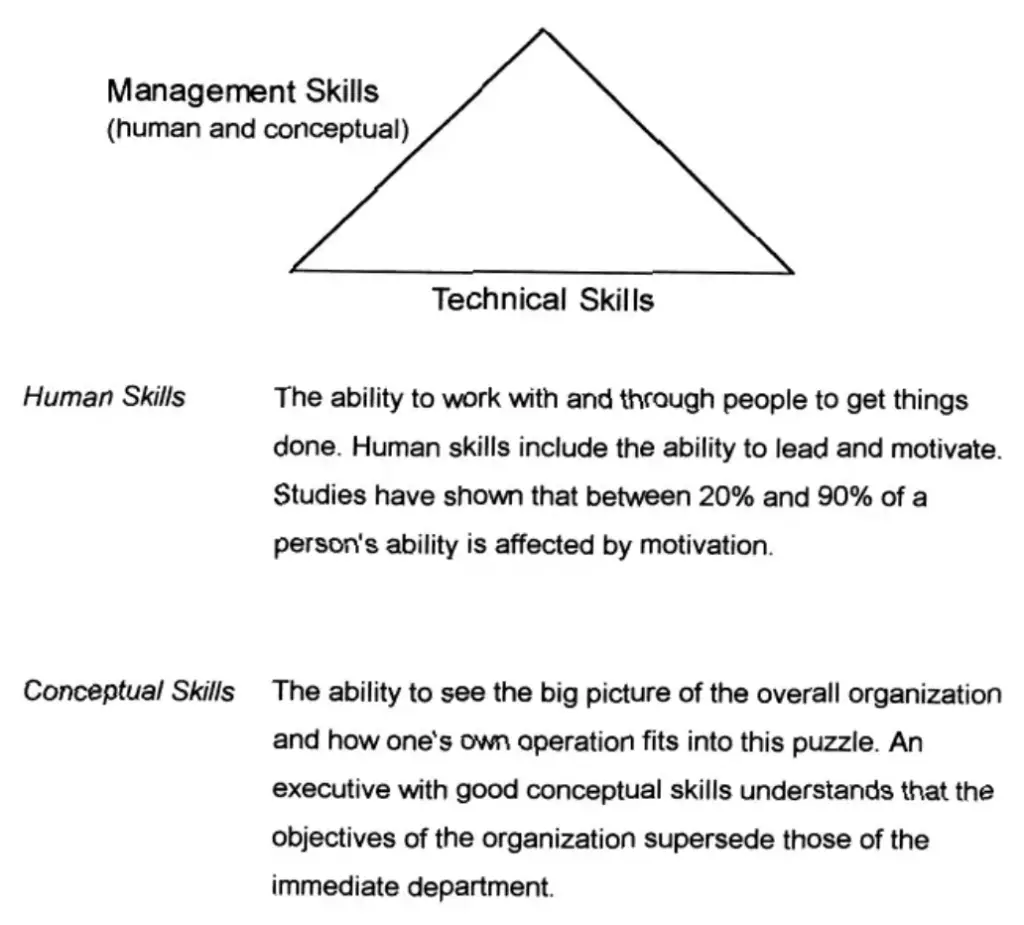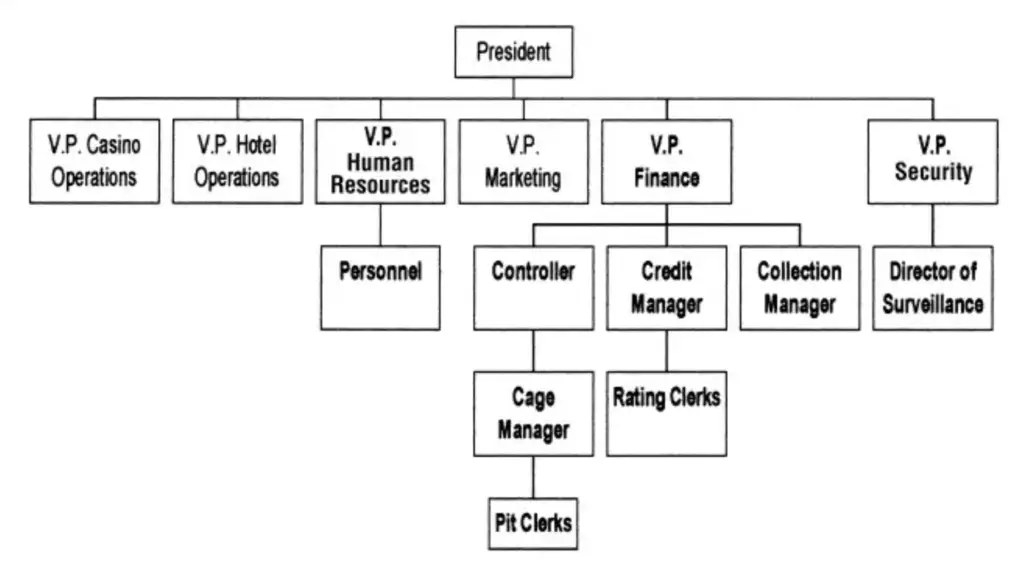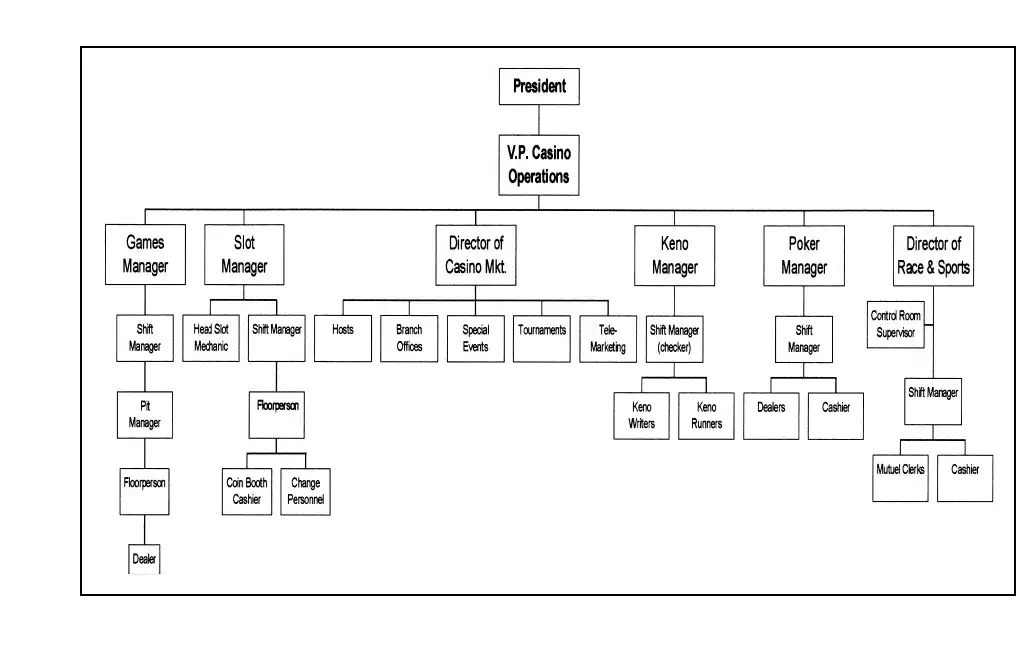The organizational structure presented in Figs. 2 and 3 would be found at a typical casino in many different gaming jurisdictions. Variations based on the size of the operation, as well as the number and type of games offered, are common. The reporting relationships and the assignment of responsibilities may also vary, depending on a number of variables, ranging from the skills and experience of the particular individuals to requirements within the specific gaming jurisdictions.
Table of Content

The typical organization starts with the president and branches out, based on functional responsibilities. The departments are divided along functional lines to provide for specialization as well as separation of responsibilities for accountability and control. The vice presidents of security, human resources, and finance all perform responsibilities that require them to operate independently of the operating department heads.
For example, it would not be in the best interest of the operation for the director of surveillance, who is responsible for monitoring activity within the casino, to report directly to the vice president of casino operations.

Although at first glance there might appear to be some benefits to aligning the organization in this manner, the director of surveillance must be free to perform responsibilities that include reporting on regulatory violations observed, as well as infractions noted involving casino personnel. The director of surveillance and his or her staff are a key part of the protection of the gaming operation and its assets, and any impairment of these responsibilities has a direct impact on the success of the operation.
Generally, the vice president of finance reports to the president directly. Depending on the ownership structure of the casino, the vice president of finance may instead have a direct reporting relationship to a representative of the owners.
The vice president of finance is a key position in any casino organization, since the responsibilities of this position include establishing and tracking performance against budgetary guidelines, auditing the results of operations, regulatory compliance, and, in most casinos, overseeing the cage, credit, and collection functions. This individual is not only a check and balance on the other operating departments but is also responsible for safeguarding the assets, including the cash maintained for the day-to-day operation of the casino.
Position in Non-Casino Organizational
The following are brief position descriptions for many of the key positions indicated in the organizational chart presented (Fig. 2) relevant to noncasino departments:

President (General Manager)
Responsible for the overall operation of the casino, including the hotel and all related operations. The responsibilities of this position are strategic as well as day-to-day in nature. Ultimately, all personnel report to the president. The person in this position reports to representatives of the owners.
Vice President of Finance
Responsible for all financial activities for the operation. Direct reports normally include accounting, cage, credit, collections, information systems (IS), and purchasing.
Vice President of Casino Operations
Responsible for the overall operation of the casino, including slots, table games, and other gaming operations such as keno, race and sports, and poker. Gaming and gaming compliance are two critical areas of responsibility for this individual.
Vice President of Human Resources
Responsible for employment, compensation, benefits, labor relations, training, and workers’ compensation functions, as well as compliance with applicable federal, state, and local requirements pertaining to these areas.
Vice President of Security
Responsible for surveillance, security, investigations, safety, and risk management, which includes handling insurance issues and guest loss complaints.
Position in Table Games of Casino Organizational
The following are brief descriptions for many of the key positions indicated in the organizational chart presented (Fig. 3) relevant to the typical casino structure:
Table Games
- Games Manager (Casino Manager): Responsible for table games operations and personnel. Supervises the shift managers.
- Shift Manager: Responsible for the operation of table games and the associated personnel during a particular shift. Supervises the pit managers and all other table games personnel during the shift.
- Pit Manager: Responsible for overseeing the operation of the table games in a designated pit. Supervises the floorpersons and dealers within the pit and is also responsible for customer relations and game protection.
- Floorperson: Responsible for supervising the operation of a group of table games within a pit. Supervises the dealers at the assigned tables.Also responsible for compliance with house rules and rating player action.
- Dealer: Responsible for the operation of a given table game. Dealers must comply with house rules for the conduct of the particular game.
- Pit Clerk: Completes pit transactions such as fills, credits, and markers through the use of the casino computer system or manually. This position may report to either cage or casino supervisory personnel.
Slots
- Slot Manager: Responsible for the operation of the slot department, including selection of machines and determination of floor configuration, as well as machine maintenance and operation. Supervises the shift managers and head slot mechanic.
- Shift Manager (Slots): Oversees the operation of the slot department, including all personnel during a particular shift. Responsibilities include customer relations and verification of large jackpot payouts.
- Head Slot Mechanic: Responsible for the maintenance and repair of all slot machines. Also maintains records pertaining to all slot machines, including location, par sheets, and any changes to the machine. Supervises and trains all of the slot mechanics.
- Floorperson: Responsible for participating in the verification and conduct of jackpot payout and hopper fill transactions. Supervises change attendants and booth cashiers.•Change attendants—Perform customer service transactions, including making change. Also responsible for an assigned bank.
- Booth cashiers: Responsible for completing jackpot payout and hopper fill transactions. Also responsible for making change and redeeming coins for slot customers.
Casino Marketing
- Director of Casino Marketing: Responsible for all aspects of marketing the casino, including developing and maintaining a database of customers. Also responsible for designing and implementing programs to attract new and repeat customer visits. Oversees operation of the slot club, casino hosts, branch offices, tournaments, and special events.
- Hosts: Responsible for identifying and attracting new casino customers, as well as servicing the needs of the existing customer base.
Other Casino Departments
- Keno Manager: Responsible for the operation of the keno department including staffing, customer relations, game integrity, compliance with gaming regulations, and financial performance.
- Keno Shift Manager: Responsible for the operation of the keno game during a particular shift. Involved in verifying payouts on winning tickets.
- Keno Writer and Runner: Provides service to customers by accepting wagers and handling payouts on winning tickets. Writers are based behind the keno counter, whereas runners go to where customers may be, such as restaurants and lounges.
- Poker Manager: Responsible for the operation of the poker department, including staffing, customer relations, game integrity, compliance with gaming regulations, and financial performance.
- Poker Shift Manager: Responsible for the operation of the poker games during a particular shift. May perform as the poker cashier as well as conducting tournament activities.
- Poker Dealer: Responsible for the operation of a given poker table. Dealers must comply with house rules for the conduct of the particular game.
- Director of Race and Sports: Responsible for the operation of the race and sports department, including staffing, customer relations, game integrity, compliance with gaming regulations, and financial performance.
- Race and Sports Shift Manager: Responsible for the operation of the race and sports book during a particular shift. Race and sports shift managers are responsible for administrative functions relevant to updating event information in the computer system as well as verifying payouts on winning wagers.
- Race and Sports Writer (Mutuel Clerk) and Cashier: Provide service to customers by accepting wagers and handling payouts on winning tickets.
Security and Surveillance
- Security Officer: Responsible for protecting the assets of the casino.Participates in casino transactions, including table fills and credits, and may participate in slot transactions, including jackpot payouts and hopper fills. Observes card and dice transfers and maintain security over the drop and count process. Controls access to keys permitting access to sensitive and restricted areas.
- Director of Surveillance: Responsible for the operation of the surveillance department, including staffing, games and guest protection, communicating with regulatory authorities, asset protection, and monitoring compliance with rules surrounding game conduct (house rules), gaming regulations, and internal control procedures.
- Surveillance Officer: Observes, records, and reports suspicious or improper activities within the casino operation. The focus is on compliance with gaming regulations, house rules, internal control procedures, and asset protection
Business Ethics
(Click on Topic to Read)
- What is Ethics?
- What is Business Ethics?
- Values, Norms, Beliefs and Standards in Business Ethics
- Indian Ethos in Management
- Ethical Issues in Marketing
- Ethical Issues in HRM
- Ethical Issues in IT
- Ethical Issues in Production and Operations Management
- Ethical Issues in Finance and Accounting
- What is Corporate Governance?
- What is Ownership Concentration?
- What is Ownership Composition?
- Types of Companies in India
- Internal Corporate Governance
- External Corporate Governance
- Corporate Governance in India
- What is Enterprise Risk Management (ERM)?
- What is Assessment of Risk?
- What is Risk Register?
- Risk Management Committee
Corporate social responsibility (CSR)
Lean Six Sigma
- Project Decomposition in Six Sigma
- Critical to Quality (CTQ) Six Sigma
- Process Mapping Six Sigma
- Flowchart and SIPOC
- Gage Repeatability and Reproducibility
- Statistical Diagram
- Lean Techniques for Optimisation Flow
- Failure Modes and Effects Analysis (FMEA)
- What is Process Audits?
- Six Sigma Implementation at Ford
- IBM Uses Six Sigma to Drive Behaviour Change
Research Methodology
Management
Operations Research
Operation Management
- What is Strategy?
- What is Operations Strategy?
- Operations Competitive Dimensions
- Operations Strategy Formulation Process
- What is Strategic Fit?
- Strategic Design Process
- Focused Operations Strategy
- Corporate Level Strategy
- Expansion Strategies
- Stability Strategies
- Retrenchment Strategies
- Competitive Advantage
- Strategic Choice and Strategic Alternatives
- What is Production Process?
- What is Process Technology?
- What is Process Improvement?
- Strategic Capacity Management
- Production and Logistics Strategy
- Taxonomy of Supply Chain Strategies
- Factors Considered in Supply Chain Planning
- Operational and Strategic Issues in Global Logistics
- Logistics Outsourcing Strategy
- What is Supply Chain Mapping?
- Supply Chain Process Restructuring
- Points of Differentiation
- Re-engineering Improvement in SCM
- What is Supply Chain Drivers?
- Supply Chain Operations Reference (SCOR) Model
- Customer Service and Cost Trade Off
- Internal and External Performance Measures
- Linking Supply Chain and Business Performance
- Netflix’s Niche Focused Strategy
- Disney and Pixar Merger
- Process Planning at Mcdonald’s
Service Operations Management
Procurement Management
- What is Procurement Management?
- Procurement Negotiation
- Types of Requisition
- RFX in Procurement
- What is Purchasing Cycle?
- Vendor Managed Inventory
- Internal Conflict During Purchasing Operation
- Spend Analysis in Procurement
- Sourcing in Procurement
- Supplier Evaluation and Selection in Procurement
- Blacklisting of Suppliers in Procurement
- Total Cost of Ownership in Procurement
- Incoterms in Procurement
- Documents Used in International Procurement
- Transportation and Logistics Strategy
- What is Capital Equipment?
- Procurement Process of Capital Equipment
- Acquisition of Technology in Procurement
- What is E-Procurement?
- E-marketplace and Online Catalogues
- Fixed Price and Cost Reimbursement Contracts
- Contract Cancellation in Procurement
- Ethics in Procurement
- Legal Aspects of Procurement
- Global Sourcing in Procurement
- Intermediaries and Countertrade in Procurement
Strategic Management
- What is Strategic Management?
- What is Value Chain Analysis?
- Mission Statement
- Business Level Strategy
- What is SWOT Analysis?
- What is Competitive Advantage?
- What is Vision?
- What is Ansoff Matrix?
- Prahalad and Gary Hammel
- Strategic Management In Global Environment
- Competitor Analysis Framework
- Competitive Rivalry Analysis
- Competitive Dynamics
- What is Competitive Rivalry?
- Five Competitive Forces That Shape Strategy
- What is PESTLE Analysis?
- Fragmentation and Consolidation Of Industries
- What is Technology Life Cycle?
- What is Diversification Strategy?
- What is Corporate Restructuring Strategy?
- Resources and Capabilities of Organization
- Role of Leaders In Functional-Level Strategic Management
- Functional Structure In Functional Level Strategy Formulation
- Information And Control System
- What is Strategy Gap Analysis?
- Issues In Strategy Implementation
- Matrix Organizational Structure
- What is Strategic Management Process?
Supply Chain



